
Chris Deich graduated from the University of Eau Claire-WI in 2016 with a B.S. in Biochemistry and Molecular Biology. He spent two years working at the Veterinary Diagnostics Lab on the UMN St. Paul campus before moving to the Adamala lab. Research interests include protobiology and using synthetic minimal cells as bioreactors. In his free time he enjoys reading science fiction, listening to music and camping on the weekends.
Works on projects jointly with Engelhart lab.
Contact: deich010@umn.edu
Building semi-synthetic minimal cells
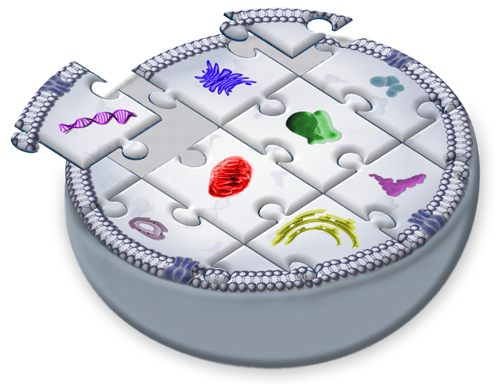
We are combining top-down and bottom-up approaches to synthetic biology; using tools of protein engineering and molecular biology, together with novel synthetic cell technologies, to understand and modulate biological processes.
Synthetic minimal cells can help us studying basic properties of life, understand the origin of life on Earth, and give guidance looking for life elsewhere in the Universe. We aim at building models for studying diseases, for creating novel therapies and for making custom biofactories.
We apply engineering principles to biology: we build life, or grow machines. This talk gives broad overview of our lab’s work.
The top-down approach involves building on the biological ensemble, modifying existing cellular pathways to explore and control biology.
The bottom-up approach involves building chemical systems capable of mimicking cellular processes – the synthetic minimal cells, that mimic properties of live cells. Those synthetic cells allow us studying and engineering complex biological pathways, building new biological functionalities, make better drugs and novel therapy strategies, and tracing the evolutionary history of life in model protocells.
bottom-up synthetic biology
Building artificial chemical systems mimicking cells
We have developed the first known system capable of non-enzymatic RNA synthesis inside model protocells.
In this work, we have shown how citric acid can stabilize fatty acid liposomes in presence of divalent cations, allowing for non-enzymatic template director RNA primer extension inside the liposomes. This discovery bridges the RNA-world hypothesis or earliest life having RNA-based metabolism with the origin of compartmentalization based on fatty acid liposomes. (Adamala and Szostak, Science 2013)
We also discovered a chemically-driven replication mechanism for model protocells (Zhu, Adamala, Zhang and Szostak, PNAS 2012).
Together, those projects allow for drawing a plausible, complete protocell cycle: inside the protocells, RNA is replicated by template-directed non-enzymatic synthesis, and the protocells grow into filamentous threads by absorbing fatty acid molecules from micelles and divide in response to shear stress.
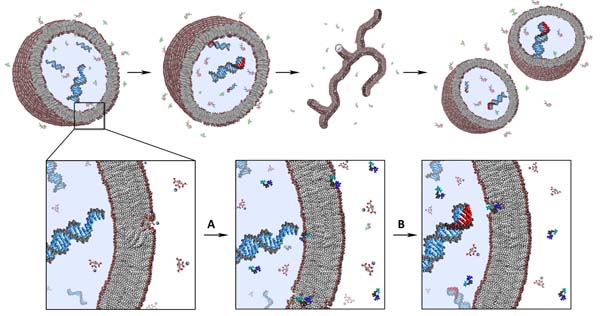 RNA replication inside protocellsdivision via threadsRNA is encapsulated
RNA replication inside protocellsdivision via threadsRNA is encapsulated in protocellsactivated nucleotides enter
via semi-permeable bilayerRNA template is copiedSource: Adamala and Szostak, Science 2013
As part of the same overarching goal of building a chemical system capable of Darwinian evolution, we have shown that an encapsulated small peptide catalyst can impact the fitness of model protocells.
I have studies catalysis of Ser-His and other di- and tri- amino acid catalytic peptides. We have shown that the minimal serine protease analogue, Ser-His, can catalyze formation of peptide nucleic acids (Gorlero et.al FEBS Letters 2009). We have also demonstrated how the same dipeptide catalyst’s activity can be enhanced by the presence of fatty acid protocell vesicles, and in turn the product of the reaction catalysed by said dipeptide allows the protocell to enhance uptake of membrane building blocks, resulting in protocell growth.
This couples the activity of encapsulated catalyst with the fitness of the protocell, in a model system exploring the origin of Darwinian selection. (Adamala and Szostak, Nature Chemistry 2013).
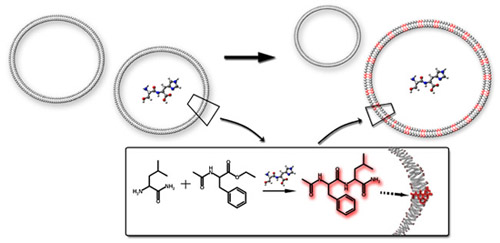 Ser-His catalysed reactionSource: Adamala and Szostak, Nature Chemistry 2013
Ser-His catalysed reactionSource: Adamala and Szostak, Nature Chemistry 2013
Work done with Pier Luigi Luisi from University Roma Tre and Jack Szostak from Harvard University.
Our most significant publications in that area:

Non-enzymatic template-directed RNA synthesis inside model protocells;
K. Adamala and J.W. Szostak,
Science 342 (2013) 1098 – 1100;
local copy pdf
publisher website link
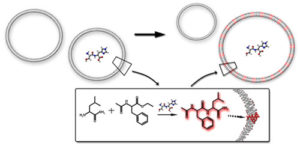
Competition between model protocells driven by an encapsulated catalyst;
K. Adamala and J.W. Szostak,
Nature Chemistry 5 (2013) 495 – 501;
local copy pdf
publisher website link
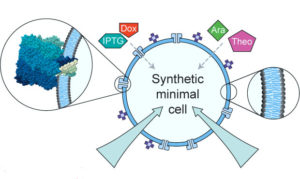
Engineering genetic circuit interactions within and between synthetic minimal cells;
Katarzyna P. Adamala*, Daniel A. Martin-Alarcon*, Katriona R. Guthrie-Honea, Edward S. Boyden;
Nature Chemistry, 9, 431-439, 2017, doi:10.1038/nchem.2644; *equal contribution
publisher website link
local copy pdf
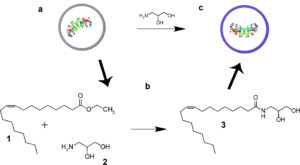
Collaboration between primitive cell membranes and soluble catalysts;
K. Adamala*, A. E. Engelhart* and J. W. Szostak;
Nature Communications, 2016, doi:10.1038/ncomms11041; *equal contribution
local copy pdf
publisher website link
Full list of peer reviewed publications: protobiology.org/publications
Broader impact
TED talk on synthetic life
Kate presented concept of building synthetic minimal cells, with its biotechnological, biomedical and basic science implications, in a TEDx talk .
Protocells in the news
The effort towards building life in the lab and elucidating the origin and earliest evolution of life has always been receiving interest from broad audience.
STAT magazine published nice overview of efforts to build artificial life, From chemicals to life: Scientists try to build cells from scratch.
Some examples of the astrobiology focus: a review detailing our work on RNA replication in protocells: Angewandte Chemie International Edtion Citric Acid and the RNA World 2014, 53, 5245 – 5247, external link (local copy pdf)
Our work on protocells have been featured in science news outlets and editorials, including:
Science Focus: Robert Service, The Life Force, external link (local copy pdf)
BioTechniques: How Cellular Life Evolved 06 Jan 2014 external link (local copy pdf)
Science News: To cook up life, just add citrate 185(1):15 external link (local copy pdf)
Science Daily: Researchers find missing component in effort to create primitive, synthetic cells, external link (local copy pdf)
Chemical & Engineering News: Lab-Made Protocells Show Hints Of Evolution, 91(21), 2013
The Panda’s Thumb: New Szostak protocell is closest approximation to origin of life and Darwinian evolution so far, external link (local copy pdf)